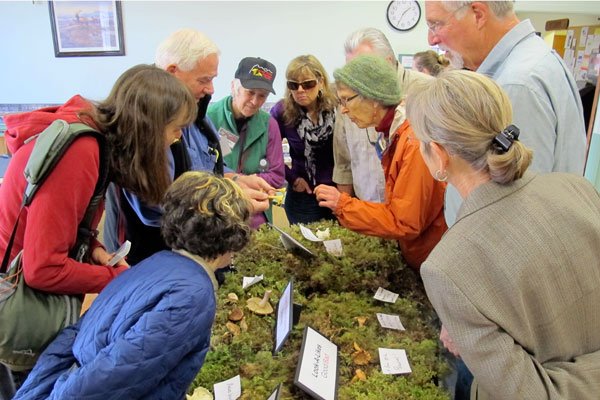The beauty, the wonder and the tastiness.
That’s the first question from mushroom newbies — “can you eat it,” says Jim Deckman, president of the Olympic Peninsula Mycological Society.
But becoming a mushroomer isn’t simply digging in.
“We stress identifying in the club,” Deckman said. “A lot of people just want to pick and eat them but we want to be safe.”
That’s one thing the club emphasizes at its annual show coming up this Saturday at the Elks Lodge.
Club members go mushroom hunting beforehand to find a variety of species that people might see in their backyard or on a hike. Approved identifiers analyze the mushrooms and sort them into edible, caution and poisonous. The show likely will feature more than 130 varieties but that varies from year-to-year, said club member Liann Finnerty.
For example, Matsutake mushrooms, a desirable mushroom internationally, were found by new club members a few years ago near Port Townsend by the trunk load but since have been hard to find.
“We live in a choice part of the world,” Finnerty said. “Rain brings out the best in mushrooms.”
Yet while mushrooms remain a big draw in the grocery store and at the Sequim show, Deckman said there are still myths about them.
“You can’t die from touching a poisonous mushroom,” Deckman said. “You have to ingest it to be poisoned. That’s where we can be of service with prevention.”
Finnerty said she and other mushroomers use keys to decipher point by point types of the fungi they discover.
“It’s not difficult to learn but can be time consuming,” she said.
To make it easier to identify mushrooms, locals can bring in bags and boxes of different types of mushrooms for identifiers to categorize.
Deckman said the mushroom show helps people learn the species in the area, which ones are poisonous and look like safe mushrooms that aren’t safe or safe for some and not others.
A toxicologist recently spoke to the club who said those most likely to eat dangerous mushrooms are the elderly, people who move from another country and misidentify mushrooms that may look like another kind back home, teenagers on a dare, small children and pets.
“We want you to be sure it’s the mushroom you think it is,” Deckman said.
Finnerty said after some time, picking mushrooms becomes like seeing an old friend.
“It’s like you’ve picked it for years and you are familiar with it,” she said. “But if you’re still not certain, then go through the (identification) keys.”
Right place, right mushroom
Even if you aren’t ready to jump in the identification bracket of mushrooming, Deckman said the club has several identifiers available at the show and in the club to help.
The number of mushroomers continues to grow, too, with active clubs around the state. Kitsap Peninsula Mycological Society hosts its show the following weekend in Silverdale and the Puget Sound Mycological Society held its show last weekend in Seattle.
“This is the time of year to collect and find mushrooms,” Deckman said.
Following the local show, the club goes on its members only trip to hunt mushrooms in the Cascades on November 2 and hosts its next meeting focusing on culinary mushrooms at 6:30 p.m. Wednesday, Nov. 13, at Gardiner Community Center, 980 Old Gardiner Road.
Membership into the club is $15 for an individual and $20 for a family.
For more information, visit olymushrooms.org.



